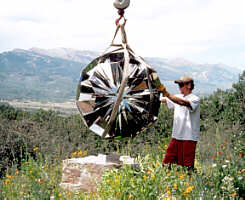|
Robert A.Hefner III Collection, Aspen, USA |
PULSEHEIGHT 3FT (1M), "Explosion and Implosion
|
|
Robert A.Hefner III Collection, Aspen, USA |
PULSEHEIGHT 3FT (1M), "Explosion and Implosion
|
For me this sculpture captures the concept of the Big Bang, and the creation of the Universe, that has been put forward by Professors Stephen Hawking and Roger Penrose. Robert A. Hefner III gave an edition of PULSE to the Aspen Center for Physics in 1999, and Damon de Laszlo gave another in 2002 to the Astronomer Royal Sir Martin Rees for the Fred Hoyle Institute of Astronomy at Cambridge University.
The surface of the sculpture, (which is missing in this sculpture), was first described by Archimedes in the 3rd century BC. We know it as the Soccer ball.
At first I built the sculpture only using the Hexagons and leaving out the Pentagons. This enabled me to see into the central space, and allowed me to realize that the strength of the structure came from the 60 points, just as in Carbon 60.
Now that I could look inside the structure I could measure the
angles of the isosceles triangle that hung from the line joining
two points, and reached into the centre. I estimated that the
centre angle would be about 25 degrees. Because the strength was
in the welds at the 60 points, why not hang isosceles triangles
with a centre angle of 30 degrees along all of the 90 seams of
the Soccer ball ? The result was not only an explosion of light in the middle of
the sculpture, but also a sense of gravity towards the centre,
thus creating a PULSE in the Forces. Explosion and Implosion.

placing the sculpture in Aspen.
© Mathematics and Knots/ Edition Limitee 1996 - 2002
This material may be used freely for educational, artistic and
scientific purposes, but may not be used for commercial purposes,
for profit or in texts without the permission of the publishers.